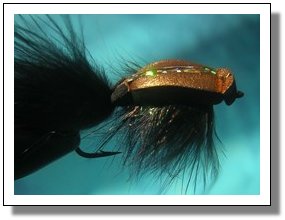
With this year's record rainfall swelling trout rivers and streams here in the Northeast (and indeed throughout much of the country), many anglers are turning to lakes and ponds for their fishing. With this in mind, I thought it would be a good time to write about one of my favorite bass flies, the Gartside Bass Bug. However and wherever you fish this fly, you can be sure it will bring many largemouth and smallmouth bass to your net. I have a reliable report from one of my midwestern clients that he's caught over five hundred smallmouth bass on just ONE of these bugs; he finally retired it when it became too chewed-up to fish any longer. I hope that you have the same success.
Tying the Gartside Bass Bug
Readers familiar with my patterns may quickly notice the similarities of the Gartside Bass Bug to the Gartside Bug. In fact, it is really the same simple fly to tie, only larger, fuller, and tied on a heavier, longer-shanked hook. And it is just as versatile. Tie it long and narrow for a floating baitfish imitation or short and broad to suggest a frog, mouse or other critter. If you want, you can even add rubber legs to the tail or body area for extra action.
While the dressing below is for a copper/black Gartside Bass Bug with a Loco Foam shell, the fly can be tied with any closed-cell foam and in an infinite variety of color combinations. Other favorite colors include: yellow/red, all-black, chartreuse/black, tan/brown, tan/grizzly, tan/black, olive/black, red/yellow, all-yellow, with the first color referring to the foam and the second color to the tail and hackle.
Hook: |
Daiichi 2141, sizes 4-1 |
Thread: |
Black or brown, Size A |
Tail: |
Black Marabou (may be short or long, sparse or heavy) |
Body: |
Peacock GSS |
Ribbing: |
Black saddle feather |
Carapace: |
Double layer of copper Loco Foam over black foam |
Cinch Material: |
Gold mylar strands (5 or 6) or 15lb test monofilament |
 Cover the shank with a layer of thread. Tie in marabou tail. Tie in cinch material. Trim excess.
Cover the shank with a layer of thread. Tie in marabou tail. Tie in cinch material. Trim excess.
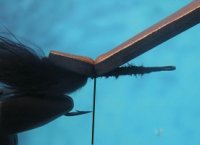 Tie in pre-cut and shaped foam on top of hook at base of tail, taking approximately ten tight turns of thread. Wind thread forward to just behind eye of hook.
Tie in pre-cut and shaped foam on top of hook at base of tail, taking approximately ten tight turns of thread. Wind thread forward to just behind eye of hook.
 Dub on a small quantity of peacock GSS and wind back to the base of the foam, covering the shank with dubbing. Tie in saddle feather by tip and trim excess.
Dub on a small quantity of peacock GSS and wind back to the base of the foam, covering the shank with dubbing. Tie in saddle feather by tip and trim excess.
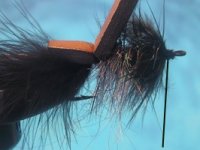 Dub on a larger amount of GSS and wind forward to just behind eye. Palmer hackle over GSS body. Tie down and trim excess. Pick out strands of GSS from body so that they blend with hackle and comb out any excess material.
Dub on a larger amount of GSS and wind forward to just behind eye. Palmer hackle over GSS body. Tie down and trim excess. Pick out strands of GSS from body so that they blend with hackle and comb out any excess material.
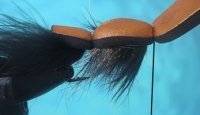 Pull foam snugly over body and tie down just behind eye.
Pull foam snugly over body and tie down just behind eye.
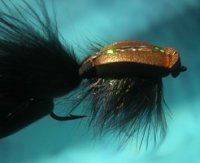 Trim rear portion of foam and pull the cinching material forward and over the top of the foam, tying it down where you tied down the forward section of foam. Wind thread in front of forward section of foam and whip-finish head. Trim forward section of foam close to eye. (Note: You can easily make this fly into a Gurgler, of course, by simply leaving a higher lip.)
Trim rear portion of foam and pull the cinching material forward and over the top of the foam, tying it down where you tied down the forward section of foam. Wind thread in front of forward section of foam and whip-finish head. Trim forward section of foam close to eye. (Note: You can easily make this fly into a Gurgler, of course, by simply leaving a higher lip.)
Fishing the Gartside Bass Bug
The Gartside Bass Bug can be fished in many ways. In a river or stream you can cast it upstream and let it dead-drift back to you. Or cast it slightly up and across stream, let it swing and then pull it under for an upriver retrieve. You can cast it straight downstream and pull it under, letting it ride back up to the surface every now and then. Or, for the more energetic fisherman, cast across stream and then, with rod held high, skitter and hop it across the surface. This skittering retrieve can often bring savage strikes from otherwise reluctant fish.
In still water, the skittering technique can work wonders as well. It takes a bit of energy to hold that rod tip high and at the same time retrieve your line while applying motion to the fly with your rod tip--but it's a technique well worth adding to your repertoire. Not feeling so energetic (or coordinated)? You can fish the fly more slowly, plopping it down among some lily pads and moving it slowly across the surface or pulling it under every now and then to let it ride back up to the surface like a wounded minnow. You may even want to try fishing it on a sinking line, deep around bottom structure where the buoyancy of the fly is less likely snag but rather float above the bottom debris.






